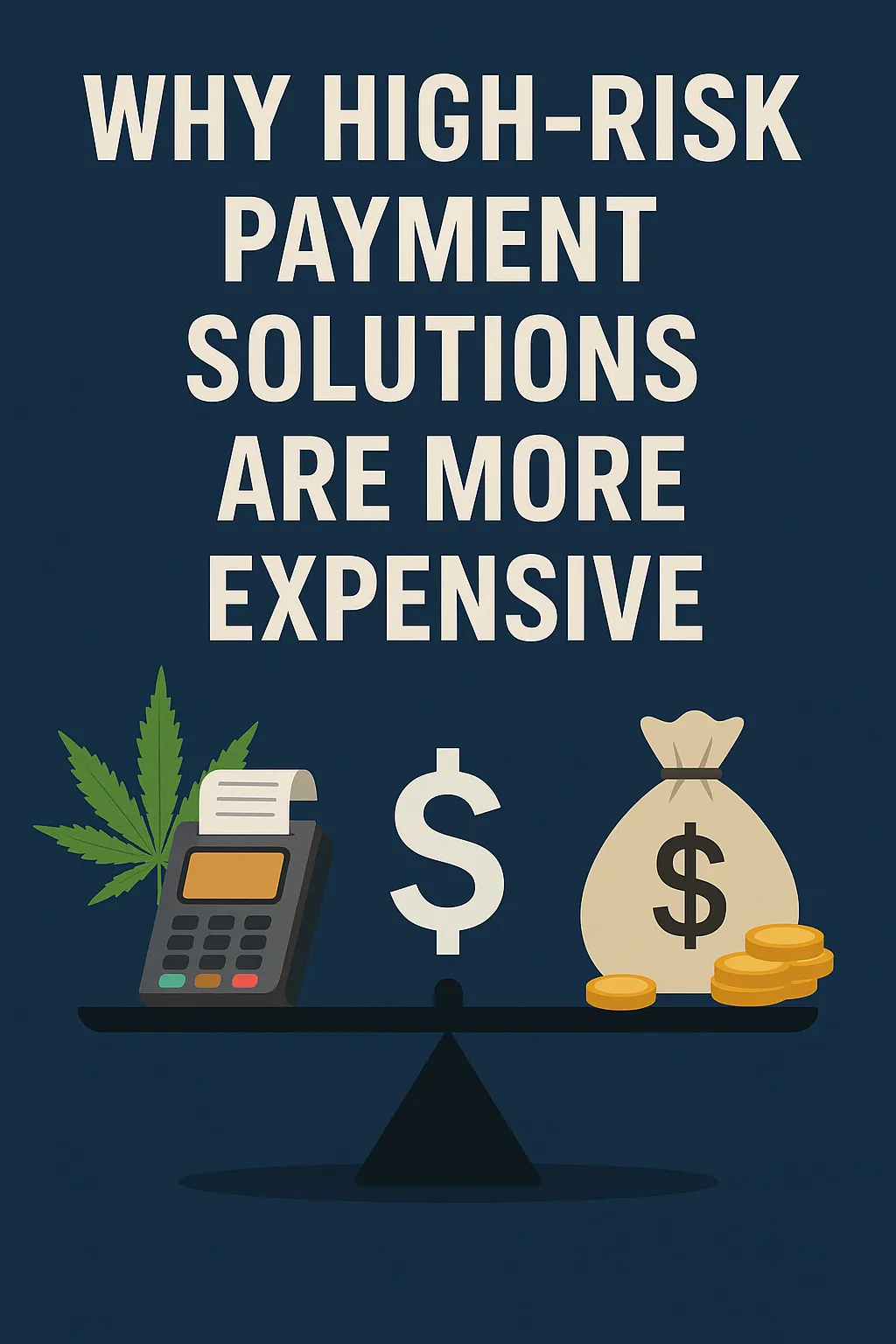Our Latest Articles

Why High-Risk Payment Solutions Are More Expensive (And What You Can Do About It)
Imagine you're launching a booming online CBD brand, opening a global forex trading platform, or running a subscription-based adult content site. The first challenge isn't getting customers—it's getting paid. You apply for a merchant account, and suddenly you’re hit with a label that changes everything: high-risk.
Not only does this label limit your options, it also drives up your costs. Higher processing fees. Steeper reserve requirements. Stricter compliance obligations. But why are payment solutions for high-risk businesses so much more expensive? And more importantly, is there anything you can do about it?
In this in-depth guide, we’ll break down the real reasons why high-risk merchant accounts cost more, how these systems work behind the scenes, and how smart merchants can reduce fees, improve trust, and scale with confidence.
1. Deep Dive: What Really Drives the “High-Risk” Label
Beyond the basics of chargebacks and regulation, let’s unpack the psychological, financial, and operational factors that push processors to label an account “high-risk.”
1.1 The Processor’s Perspective: Expected Loss Modeling
Payment processors build complex loss‐forecasting models that evaluate every new merchant application. They combine:
Historical Industry Data. If adult-entertainment merchants in the past have averaged 2.5% chargebacks, that becomes a starting assumption.
Merchant History. New businesses lack track records, so processors may apply a worst-case “greenfield” surcharge.
Projected Volume. High volume + high volatility = magnified exposure.
Geography. Cross-border or emerging-market sales carry additional fraud risk.
Payment Mix. A reliance on credit cards (easily chargebacked) versus ACH (harder to reverse).
Example: a CBD brand selling globally with projected annual volume of $5 million might be assessed a 4% “model loss rate” versus 0.8% for a traditional clothing retailer.

1.2 The Chargeback “Tax”
Processors often treat excessive chargebacks like a tax. Beyond flat fees, you may incur:
Excessive Chargeback Penalties. Payslips can show monthly “over‐threshold” penalties (e.g., $100 for each dispute beyond 1%).
Exclusionary Lists. Schemes like the Mastercard Excessive Chargeback program can lead to network fines or even termination.
Reimbursement of Retrieval Costs. Even “won” disputes can cost the merchant $15–$25 in retrieval fees.
Case Study: One subscription-box merchant slashed chargeback costs 70% by switching from one‐click “confirm” upsells to explicit email opt-in renewals, thereby avoiding customer confusion and disputes.
2. Anatomy of High-Risk Fee Structures
Let’s dissect each component of your merchant-statement and understand where negotiations can happen.

Tip: As you build volume, pitch your processor on a tiered‐rate structure. “If I exceed $250K/month, I’d like to reduce my transaction fee margin by 0.5%.” Showing a path to growth can unlock lower rates.
3. Mastering Negotiation: Talking Dollars & Sense
Many merchants accept the first rate sheet they see—and leave thousands on the table. Here’s how to negotiate like a pro.
3.1 Arm Yourself with Data
Benchmark Your Industry. Use public‐domain reports (e.g., Nilson Report, Aite, Juniper) to cite average chargeback rates or merchant fees.
Show Historical Performance. If you’ve operated under 0.5% chargebacks for two years, make that part of your pitch.
Project Growth. Present realistic forecasts with concrete marketing and sales plans.
3.2 Structure Your Ask
Rather than “I want a lower fee,” frame it as:
“Given our consistent 0.4% chargeback rate over 18 months and projected $500K/month volume by Q4, can we structure a rate of 3.2% + $0.30, with release of rolling reserve after 120 days?”
3.3 Layered Leverage
Competitive Quotes. Garner proposals from at least three processors. Use the best offer as leverage.
Bundling Services. Processors prefer merchants who use both acquiring and gateway services. Bundling can unlock discounts.
Contract Length vs. Flexibility. Longer agreements can get you lower rates—just insist on exit clauses if fees aren’t met.
3.4 Beware of Fine Print
Merchant Category Codes (MCC). Some processors misclassify your MCC to a higher‐risk code. Verify you’re using the correct one.
Volume Threshold Clauses. Ensure penalty rates only kick in if you truly exceed the volume.
Reserve Release Conditions. Clarify precisely what performance metrics trigger reserve release (e.g., <0.5% disputes, no major incidents).
4. Advanced Risk Mitigation & Fraud Controls
You’ve seen the basics; now let’s level up with enterprise-grade tools and techniques.
4.1 Real-Time Fraud Monitoring & Automation
Invest in platforms (e.g., Riskified, Sift, Forter) that provide:
Dynamic Rulesets. Block or flag transactions based on velocity, geography, device risk score.
Behavioral Biometrics. Detect non-human patterns in mouse movement or typing.
Machine-Learning Models. Continuously adapt to emerging fraud tactics.
4.2 Progressive KYC & KYB
For B2B or large ticket sales:
Tiered Identity Verification. Small transactions use lightweight verification; large ones require document upload.
Ongoing Monitoring. Refresh KYB data quarterly for corporate accounts to catch beneficial-owner changes.
4.3 Tokenization & Vaulting
Single-Use Tokens. Replace card data with one-time tokens to mitigate data-breach risk.
Network Tokenization (e.g., Visa, Mastercard). Enable network-issued tokens that survive card re-issues, reducing declines.
4.4 3-D Secure 2.x (3DS2)
Implement frictionless authentication flows:
EMVCo-Certified Integrations. Maximize challenge-exemption rates to keep user drop-off low.
Smart Routing. Fall back to OTP only when risk demands it, preserving conversion.
4.5 Hosted vs. API Gateways
Hosted Checkout Pages. Let your processor handle PCI-scope at the cost of brand control.
Direct API Integrations. Full control + seamless checkout—but you bear PCI compliance burdens.
5. Diversification: Beyond Credit Cards
Relying on a single payment rail is a recipe for revenue concentration risk. Here’s how to broaden your payment ecosystem:
5.1 ACH, eCheck & Direct Debit
Lower Fees. Often under 1% or flat fees.
Longer Settlement. 2–4 business days vs. instantaneous card authorizations.
Reduced Chargebacks. NACHA rules allow only 60 days for returns versus 120 for cards.
5.2 Cashless ATMs
Benefits: Lower cost for the merchant (dependent on volume, merchant may not pay anything). Customer's pay "out of network" ATM fee.
Implementation: Terminal needs to be enabled. Easy training of staff.

6. Compliance Deep-Dive: Rules, Licenses & Jurisdictions
Depending on where you and your customers sit, compliance can be a minefield. Here’s how to navigate it.
6.1 CBD & Cannabis
U.S. Federal vs. State Law. While the 2018 Farm Bill legalized hemp‐derived CBD (≤0.3% THC), the FDA has yet to grant GRAS status. Processors demand COAs (Certificates of Analysis) and batch testing records.
International Restrictions. EU and Canada permit CBD under different thresholds; Asia and the Middle East are far more restrictive. Adapt your site’s geo‐blocking accordingly.
6.2 Forex & Crypto Trading
Licensing. Most jurisdictions require an FCA, CySEC, or equivalent license. Even offshore brokers must prove KYC/AML policies.
Transaction Reporting. Regulators may demand suspicious‐activity reports (SARs) for large crypto transfers.
Segregated Accounts. Many oversight bodies insist on client‐fund segregation from operating capital.
6.3 Adult Entertainment
18+ Verification. Age‐gate scripts are inadequate. You need reputable third-party age‐verification vendors.
Obscenity Laws. Some jurisdictions ban specific content; geo-block proactively.
Payment Processor Tolerance. Many mainstream banks avoid any adult sector; you’ll need an adult-friendly acquirer.
6.4 Gambling & iGaming
Jurisdictional Licenses. MGA, UKGC, Curacao—each with its own capital, reporting, and audit requirements.
Geo-Blocking. Fines for serving restricted jurisdictions can reach 5–10% of GGR.
Self-Exclusion Programs. Legal mandate in many regions (e.g., GamStop in the UK).
6.5 Subscription Models & Continuity
Lead Generators vs. Direct Merchant. Lead‐gen affiliates can create hidden dispute triggers—processors often require you to be the direct merchant of record.
Negative Option Billing. Must include clear “cancel at any time” language and easy cancellation methods to avoid FTC action.
7. Case Studies & Voices of Experience
Let’s learn from merchants who turned their high-risk handicap into an advantage.
7.1 CBD Skincare Startup
Situation: Early-stage CBD brand faced 6% transaction fees and a 7% rolling reserve.
Actions:
Updated all COAs to ISO/IEC 17025 standards.
Migrated to a specialized CBD processor offering 3.9% + $0.30 with a 4% reserve.
Negotiated a reserve reduction after three months of <0.3% disputes.
Result: Saved $12K+/month in fees and unlocked $100K in previously withheld reserves.
7.2 Forex Brokerage
Situation: $20 million annual volume but plagued by AML red flags and patchy KYC.
Actions:
Engaged a RegTech partner to automate KYC/AML checks (under 2-minute onboarding).
Switched to a tiered processor charging 0.2%–0.4% per transaction instead of flat 1.5%.
Provided quarterly compliance reports to the processor.
Result: Approval rate jumped from 85% to 96%, driving $300K extra revenue and a 30% fee reduction.
7.3 Subscription Dating Site
Situation: Recurring fees led to high “didn’t cancel” chargebacks.
Actions:
Implemented a “grace period” reminder email 3 days before renewal.
Added one-click “Pause Subscription” in account settings.
Integrated Ethoca alerts to resolve disputes before chargebacks filed.
Result: Chargeback rate dropped from 1.8% to 0.6% in six months; processor cut fees from 5.5% to 4.2%.
8. Roadmap: A 6-Month Plan to Tame Your High-Risk Profile
Use this tactical playbook to advance from “high-risk” to “preferred merchant.”

9. Frequently Asked Questions
Q: How low can high-risk transaction fees realistically go?
A: With consistent performance, top processors may drop you to 2.8%–3.2% plus $0.20–$0.25 on volume ≥$1 million/month. Achieving this typically requires <0.3% disputes and strong AML/KYC practices.
Q: Is it better to use multiple processors?
A: Yes. A dual-processor setup can:
Reduce single-point failures if one gateway has downtime.
Let you route specific payment types (e.g., crypto vs. cards) optimally.
Create competitive pressure to keep rates low.
Q: What’s the difference between a rolling reserve and a chargeback reserve?
A: A rolling reserve withholds a percentage of all sales for a set period. A chargeback reserve holds only enough funds to cover open disputes. Some processors blend both; always ask for clarity.
Q: Should I absorb chargeback fees or pass them to customers?
A: Passing them on may violate card-network rules and anger customers. Instead, build fee buffers into your pricing or implement dynamic routing to the cheapest rail.
Q: When should I re-negotiate rates?
A: Every 6 months if your volume/dispute profile has improved. Even if your current rates are working, the mere prospect of business growth can get you better terms.
10. Future Trends: What’s Next in High-Risk Payments
Stay ahead of the curve by watching these emerging shifts:
AI-Driven Underwriting. Instant risk scoring at onboarding—good for low-volume specialists.
Decentralized Identity (DID). Self-sovereign identities could streamline KYC across multiple processors.
Central Bank Digital Currencies (CBDCs). May open new rails with lower fees and near-instant settlement.
Embedded Finance. Square-style “buy now, pay later” built into niche platforms (e.g., adult content subscriptions).
Real-Time Regulatory Reporting via APIs. Expect regulators to demand near-instant transaction transparency.
11. Key Takeaways & Action Items
Know Your Numbers. Chargeback ratio, approval rate, average ticket size—track daily.
Invest in Prevention. A dollar spent on fraud tools often saves $4–$10 in fees.
Negotiate Ruthlessly. Use data and competition to secure tiered rates and reserve concessions.
Diversify. Don’t let a single rail (or processor) hold your business hostage.
Build for Re-classification. Every month of low disputes and cleared reserves brings you closer to “low-risk” status.
Your Next Step: Pick one quick win—perhaps your billing descriptor or a fraud-scoring integration—and implement it within two weeks. Then measure the impact. The momentum you build will fuel your next round of negotiations and fee reductions.
READY TO HAVE A CONVERSATION?
We have a LOT of experience in the high-risk markets. While most payment processors have one or two suppliers they utilize we have multiple, (as in 8 at last count).


